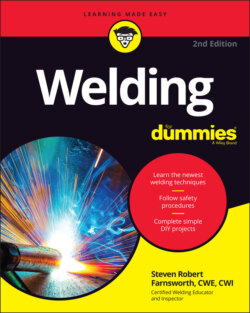Читать книгу Welding For Dummies - Steven Robert Farnsworth - Страница 54
Wearing protective clothing
ОглавлениеIf you’ve ever thought of yourself getting started on your first welding project wearing a pair of shorts, an old t-shirt, and a pair of flip-flops, think again. If you want to keep your body safe from the hazards of welding — especially burns — you have to always wear appropriate protective clothing.
Welding produces a huge amount of hot metal sparks and flying slag (molten metal). To keep your skin from being burned, choose clothing made from the right material. One of the best options is 100-percent wool, but it can be difficult to find and is extremely hot. (Some people are also allergic to wool.) I prefer 100-percent cotton, and it’s the most popular material used for welding clothing. The fabric should be thick (because welding rays can penetrate thin fabric and burn your skin like a sunburn) and dark-colored; black and dark blue are good options.
Sorry, but you can’t use that old polyester leisure suit from the ’70s when you’re welding. Synthetic fabrics like polyester, nylon, and rayon are unsafe for welding because they can melt and adhere to your skin when they get hot. And that definitely does not promote leisure.
Before welding, check to see that your clothes are free from oil and anything else flammable. They should also be tight fitting and free from holes and frayed or torn edges. Here are a few more clothing-related details to bear in mind.
Shirts: Wear long-sleeved shirts only, and tuck your shirttail into your pants. If you wear a shirt with front pockets, make sure they have flaps covering them so that sparks can’t fall down inside. Keep your shirt sleeves rolled down at all times.
Pants: Make sure your pants cover the tops of your shoes or boots so that sparks can’t get in.
Gloves: Protect your hands with leather gauntlet gloves. Don’t wear cotton gloves at any time.
Boots or shoes: Go with leather boots or shoes, and make sure they come up high on your ankle. Leather is the best option because it protects you from the hazards and heat created by the welding process. The tops of the shoes should be smooth so sparks don’t get trapped.
Hats or beanies: You can buy a welder’s beanie to keep your hair from catching fire — not a bad idea.
Leather jackets: A full leather jacket protects you from sparks and slag when you’re doing work in unusual positions, but many such jackets are very hot and heavy to wear. If a leather jacket is too hot and uncomfortable, you can buy leather sleeves and bibs only. These items are cooler and more comfortable, but they do leave your back unprotected.
Leather aprons: These items protect your lap, and I highly recommend wearing one if you plan to sit down while welding.
Spats: If you’re going to have a large amount of sparks and slag (the waste products that come from the flux) falling at your feet, you may consider getting some spats (shoe covers). Leather spats greatly reduce the risk of burns on your feet and damage to your shoes or boots.
Be careful what you have in your pockets when you weld. If you have a cigarette lighter or matches in your pocket during a welding project and a spark gets close enough, it can cause a fire in your pocket.
